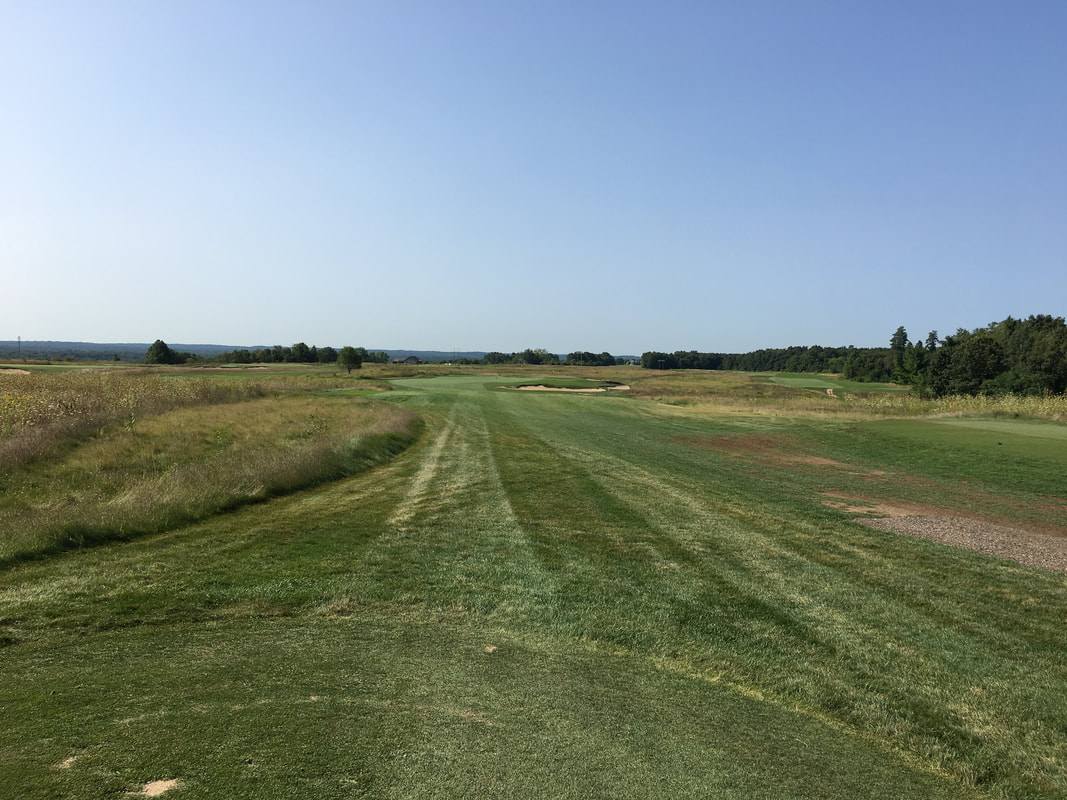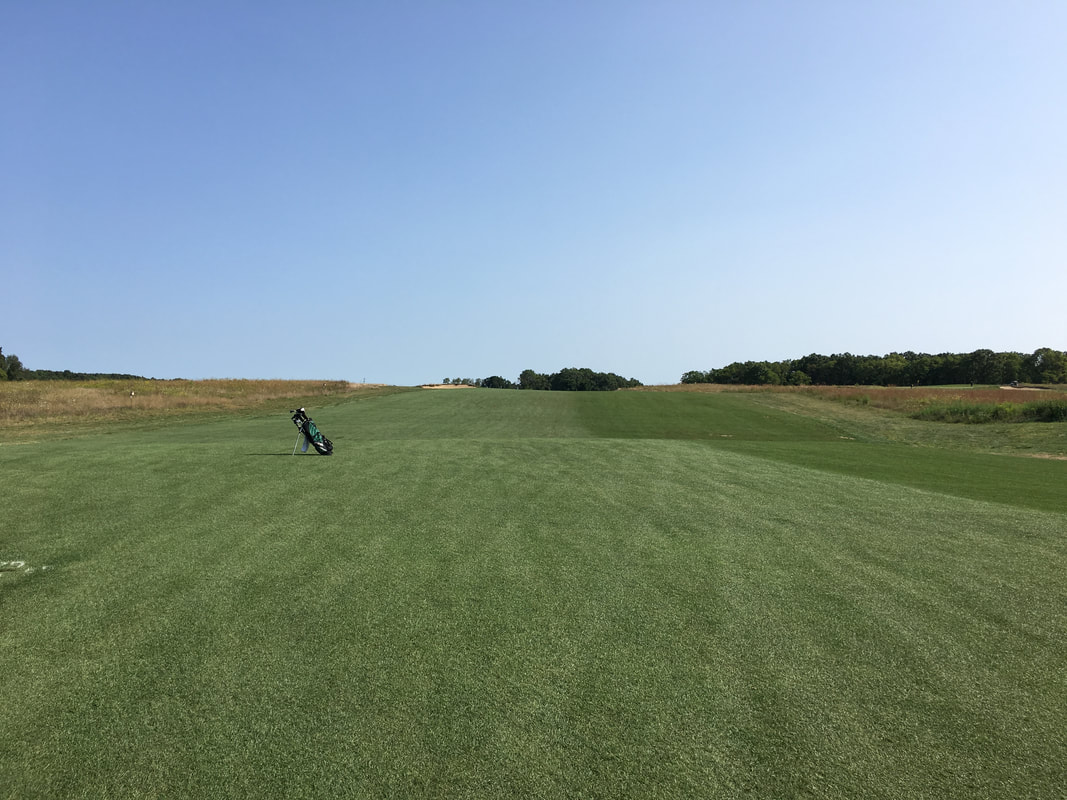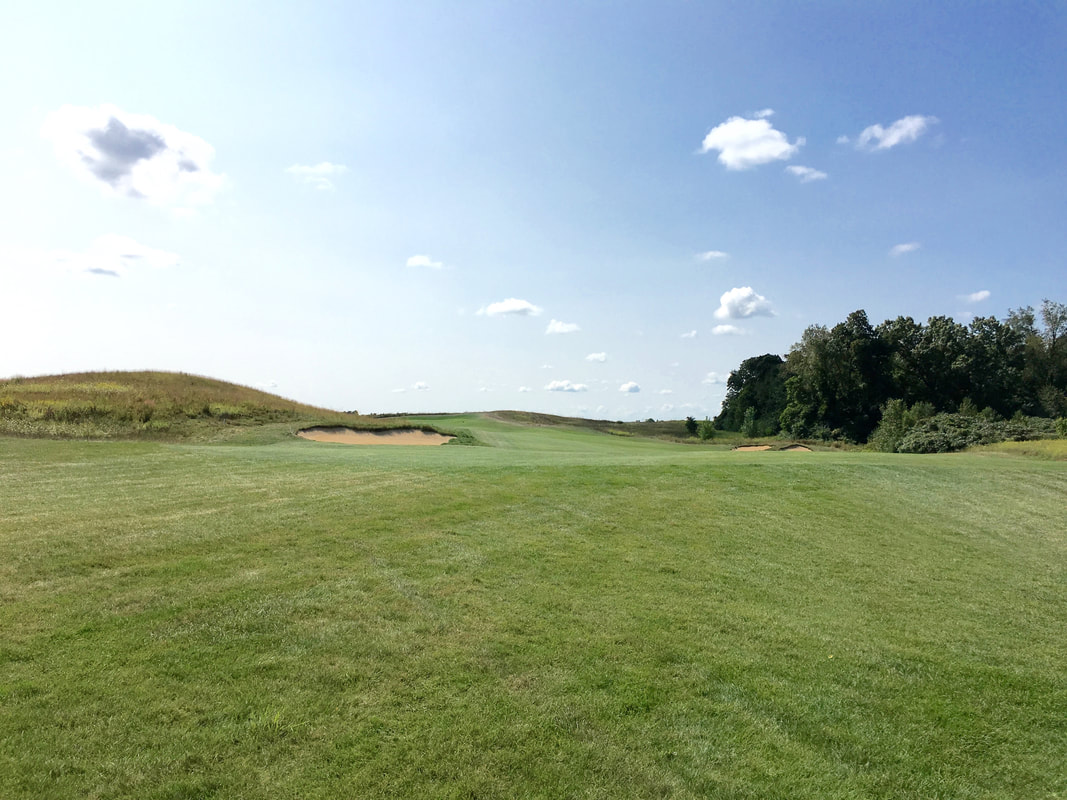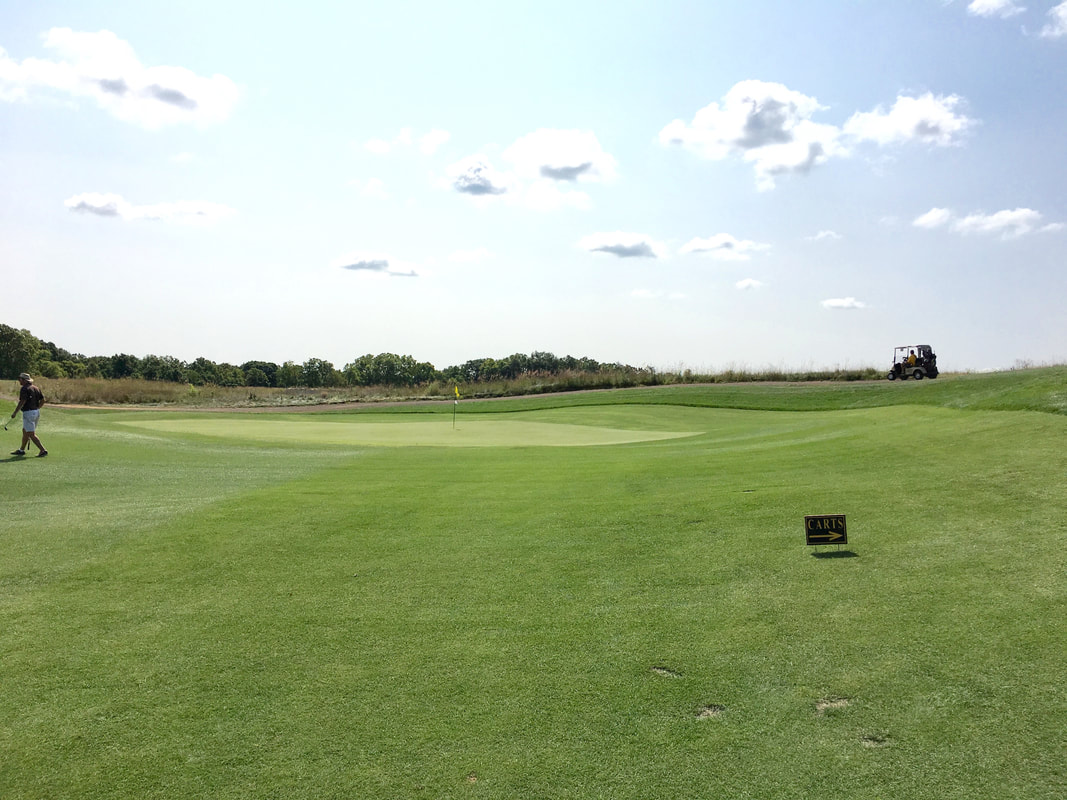Station Brae is the sixth and newest addition to the Gull Lake View Resort and while I never had much interest in taking the two hour drive out past Battle Creek to play the other five, when I heard that Tom Doak’s Renaissance Golf Design associates were building the course, I became very interested. That aside, the property offered plenty of potential; a high rolling meadow (highest point in the area) with enough contour throughout for interesting holes and some steep contours at the edges for dramatic ones. At the first opportunity in the summer of 2017, I came out here to have a look.
And I wasn’t disappointed. The course sits gracefully on the land, with minimal shaping and relatively few bunkers. But shaping and bunkers are used very efficiently, the former mostly to create interest on and around greens and the latter to create strategic rather than (for the most part) visual interest. The course was impossibly firm when it first opened in 2017, which made it very difficult to hit the greens. But before I came back to the course in 2019, I noticed that they had gotten absolutely crushed for this by Google reviewers and went, I thought, too far in the other direction, with the greens playing very soft in the middle of a dry summer. Hopefully they’ve found the right balance since.
The first hole plays semi-blind over a ridge to a narrow, crowned green. This green was a nightmare to hit when the greens were firm in 2017 and I feared that they’d had created a bit of a first-at-Greywalls situation here. But when the greens were softer in 2019, I realized that it’s fine. Right and long are terrible, but like Pinehurst #2, the slope left of the green only takes your ball a few feet away and there’s ample safe room short.
And I wasn’t disappointed. The course sits gracefully on the land, with minimal shaping and relatively few bunkers. But shaping and bunkers are used very efficiently, the former mostly to create interest on and around greens and the latter to create strategic rather than (for the most part) visual interest. The course was impossibly firm when it first opened in 2017, which made it very difficult to hit the greens. But before I came back to the course in 2019, I noticed that they had gotten absolutely crushed for this by Google reviewers and went, I thought, too far in the other direction, with the greens playing very soft in the middle of a dry summer. Hopefully they’ve found the right balance since.
The first hole plays semi-blind over a ridge to a narrow, crowned green. This green was a nightmare to hit when the greens were firm in 2017 and I feared that they’d had created a bit of a first-at-Greywalls situation here. But when the greens were softer in 2019, I realized that it’s fine. Right and long are terrible, but like Pinehurst #2, the slope left of the green only takes your ball a few feet away and there’s ample safe room short.
After a long par 3 to a bowl-shaped green, we come to the first of three long, back-and-forth par 4s. Some might find these holes a bit similar and superficially, that may be true. Each creates a different set of tasks; the third has a fairway bunker left but is wide open on the right, however the elevated green has a front right bunker, giving him who hits it down the middle to have the best chance to run it on. The fourth doglegs slightly to the right around a bunker and if you can carry or skirt it, you won’t have to play around the bunker front right. The fifth is probably the most difficult of these three holes; a dogleg left around bunkers with a tighter fairway and another bunker on the right, to a narrower green that with two bunkers in the front right, only provides a good angle to those who have carried the left fairway bunkers.
The par 5 sixth is very long but at least until you get near the green, very wide open. The key thing to do here is hit your shots solidly to avoid having too long an approach. The next two holes, a long par 3 and a short par 4 are my two favorite on the front nine. The seventh is a very English hole; a 220 yard uphill par 3 with carry bunkers short of the green and all short grass beyond. These bunkers create a nice visual illusion because they seem to be the hole’s major challenge but unless you duff your tee shot, they won’t come into play—at their closest, they’re about 40 yards short of the green. You can just the gentle right-to-left slope of the land to feed your ball onto the open green, which has a tough front right tier but is otherwise pretty receptive.
The eighth is an excellent, but difficult short par 4. There’s plenty of room left but if you think a little about what the architect is probably up to, you’ll realize that hitting it there will leave a difficult approach. And this is correct; the green is narrow and has a false left edge. If you carry the fairway bunker, you’ll have a straightforward and short approach. This was another green that I thought was impossible to hit when the course was playing firm in 2017, but worked much better in 2019. Like the first, the slope off the left edge of the green is done just right. If you miss here, the ball will only run 10 or 15 feet away from the green and leave a shot that could come back to your feet, but one from which this isn’t the most likely outcome (unlike a lot of these collection areas on newer courses).
The long par 5 ninth is a good example of what I meant when I said that the course is efficiently bunkered. There are 3 bunkers in its 565 yards, one right off the tee, one left in the lay-up area at the top of the hill, and one right of the green. If you skirt the first one on the right, you can play around (rather than over) the second one on the left to get your ball on the optimal (left) side of the fairway to play down the angle of the green (front left to back right) and not over the bunker on its right. It’s a simple design that could work on most land, but works even a bit better here because of the placement of the left fairway bunker at the apex of the hill, not just creating a carry hazard but obscuring the optimal lay-up area.
The next four holes are over the most dramatic property, playing around a big ridge that runs from just left of the thirteenth fairway, through the tenth green and eleventh tee and out across the middle of the twelfth fairway. These holes are all very good to excellent and the tenth is maybe the best. The highest point of the ridge is a hill between the tenth and thirteenth fairways. It forms the primary driving hazard on the tenth—if you hit a good drive over the edge of it to the left, you’ll be left with the optimal angle to the front left to back right-angled green. The weaker a drive you hit, the more this ridge will carry your tee ball toward the right rough, which leaves a very tough angle. This hole reminded me of the holes in the middle of the front nine at the Kingsley Club and would be a standout even in that excellent stretch.
After the photogenic ridge line par 3 eleventh, we come to a somewhat awkward-looking tee shot on number twelve. Unless you’re a short hitter and you have to keep it short of the two big fairway bunkers or try to skirt their right edge, it looks more difficult than it is. The fairway is very wide over these bunkers and runs downhill to the large, undulating green. A long hitter could get it close to the green.
The long par 4 thirteenth might be my favorite hole on the course. It’s a dogleg left around the aforementioned hill with a reverse camber fairway sloping toward a single fairway bunker right. It’s very important to hit it up the left side and with a draw to keep your second shot to a reasonable length. The second shot, while mostly blind, is a great one; through a saddle to a bunkerless punchbowl green. This is one of the best green sites that I’ve ever seen for a long par 4. There’s plenty of space to run the ball onto the green and it’s receptive, as long as you err right.
After a downhill par 3 to a shallow green with a deep fronting bunker and a false front, we come to another great hole: the medium-short par 4 fifteenth. The tee shot is across a valley (or uphill from the middle tees) to an uphill fairway with a single small bunker on the left, on the line to the green. While you’d have to hit a very long drive to carry it and set up a clear view to the green, there’s still good reason to play near it even if you can’t do this and still have a blind second shot. That’s because the green opens up from the left and sits in a saddle, but with a much higher right side than left side. From the left-center of the fairway, you’ll be playing your approach into this slope, which makes it pretty easy to get at more hole locations.
The final three holes consist of two par 5s and a par 3 sandwiched in between. The sixteenth is fairly straight forward. Keep it short of the bunker in the middle of the fairway and left of center on the approach unless you’re going for the green, in which case there’s a bunker about 30 yards short of the green that you’ll need to carry. The seventeenth is an excellent medium short par 3 to a small green with a false front. Although I haven’t been there, this reminds me of pictures that I’ve seen of Prairie Dunes in Kansas and I’m sure it would fit in well on that great course.
The eighteenth is one of the more intimidating tee shots on the course, with the left hand fairway bunker encroaching into the middle of the fairway. But this bunker is further out than it appears and I would think that all but the longest hitters would stay short of it off a normal drive. The lay-up zone slopes left to right and the green is perched to the left over a large and deep collection area. The closer you get to the green, the more awkward your stance becomes (downhill and sloping to the right) unless you keep your lay-up down the left side. Unless you can go for the green, it’s probably best to lay well back.
Station Brae is an excellent addition to a southern mid-Michigan region that has a lot of golf courses, but few really good ones. This one is near the top of the heap (I think that only Pilgrim’s Run is better) and holds its own with the best public courses in the state. I have it inside the top ten—the course gets a lot of strategy out of limited bunkering and shaping and is also a very pleasant walk. Perhaps many of the holes will come off as too similar to a lot of people but as I discussed with nos. 3-5, they’re not as similar as they look. The course appears to be cost efficient in terms of maintenance, with mixed bluegrass fairways. But I found these fairways to be firmer than the bluegrass fairways at Diamond Springs, which made it easier to use the contours of the ground. Although Stoatin Brae is much pricier than Diamond Springs (peak weekend rates of $95), this isn’t unreasonable considering the quality of the course.

























 RSS Feed
RSS Feed